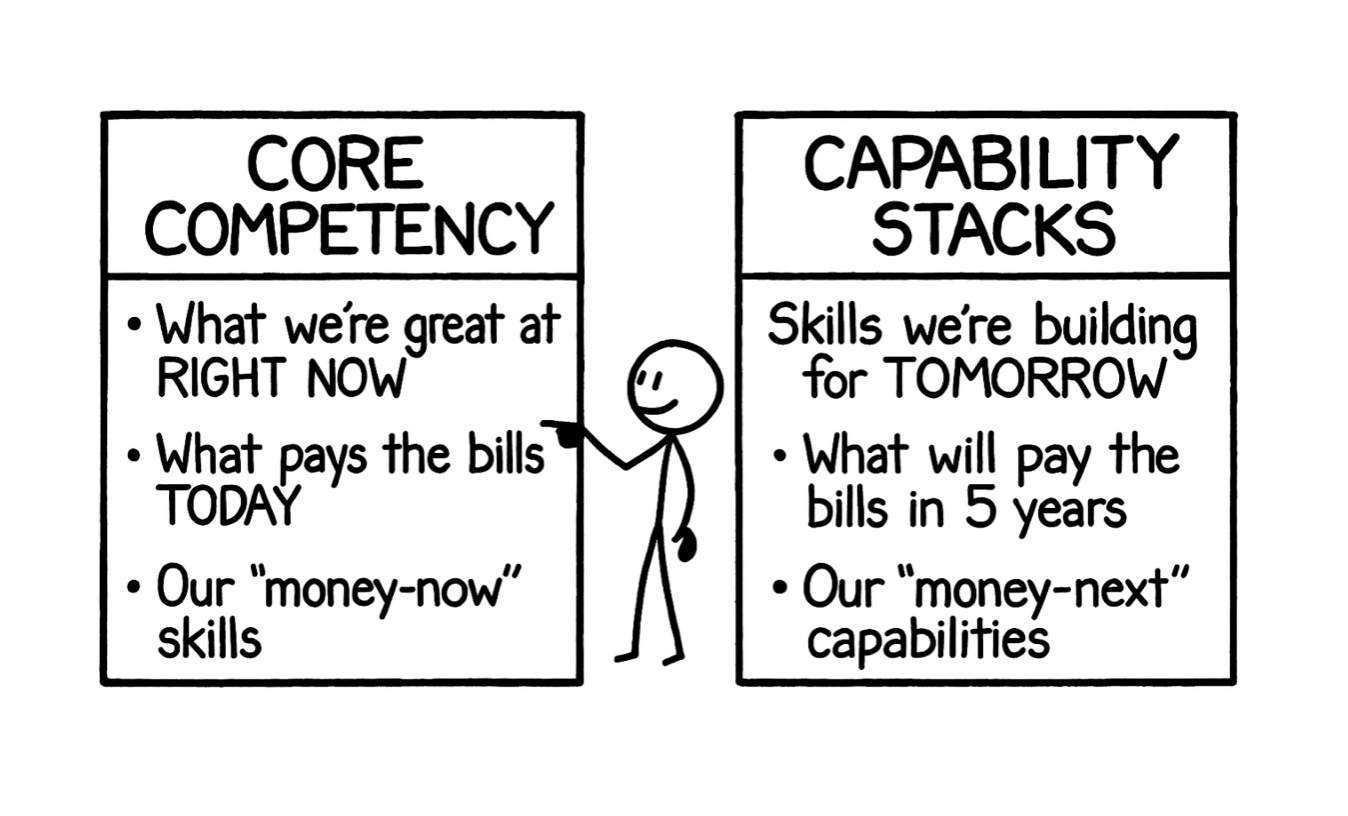The Two Boxes Exercise: A Field Guide for Your Team
Welcome! You’re One Inch Ahead Already 🎯
What You Need to Know First
If you’re reading this, you just took the first step toward making your team future-ready.
This isn’t another corporate transformation program. It’s a simple conversation that’ll take 20 minutes. And might just change how you think about your work.
The Two Boxes Framework
Think of your organization’s capabilities in two simple boxes:
📦 Box 1: Core Competency (Dark Blue Box)
What you’re great at RIGHT NOW
What pays the bills TODAY
Your “money now” skills
📦 Box 2: Capability Stacks (Green Box)
Skills you’re building for TOMORROW
What will pay the bills in 5 years
Your “money next” capabilities
Here’s the thing: Most companies only polish Box 1. They perfect what they already do, until the world moves on and nobody needs it anymore.
Remember Kodak? Blockbuster? They were MASTERS of their core competency. They just forgot to build new capability stacks.
Meanwhile, companies like Novartis and Yamaha keep adding to Box 2. They went from dye-making to drug-making. From acoustic pianos to digital keyboards. They stayed relevant by staying one inch ahead.
Not ten steps. Not five years. Just one inch, but consistently.
Why This Matters
If you only focus on Core Competency, you risk perfecting something the world no longer needs.
If you keep adding Capability Stacks, you’re preparing for multiple possible futures.
Stop perfecting. Start collecting.
How to Run This Exercise (25 Minutes)
What You’ll Need:
Your team (3-7 people works best)
A whiteboard or large paper
20 minutes of uninterrupted time
Open minds (mandatory)
Step 1: Set the Stage (3 minutes)
Draw two boxes on your whiteboard. Or just print out the image above.
Explain the framework simply:
Left box = What we do now
Right box = What we need to learn next
Share one example: “Yamaha used to only make acoustic pianos. Then they built capability in digital keyboards, synthesizers, and music software. That’s how they survived when piano sales dropped.”
Step 2: The Core Question (15 minutes)
Now ask your team:
“What’s ONE capability our industry will absolutely need in five years—and we must start building TODAY?”
Have everyone take 2 minutes to think silently first. No talking. Let people actually think.
Then go around the room. Everyone shares one capability. No judgment yet. Just listen.
Write them ALL down in the green box area.
You might hear things like:
“AI and data analytics”
“Supply chain transparency”
“Community building”
“Personalization at scale”
“Sustainability metrics”
Whatever comes up, write it down.
Step 3: Rank and Reality Check (2 minutes)
Now look at your list together and ask:
Which ones feel URGENT?
Which ones would make us irreplaceable?
Which ones are our competitors NOT building yet?
Put a star ⭐ next to the top 3 capabilities.
Step 4: Pick ONE (5 minutes)
Here’s the hard part: Pick just ONE to start with.
Ask:
Which capability could we experiment with NEXT WEEK?
Which one has a champion willing to own it?
Which one would teach us the most?
Circle that one. That’s your next inch. That’s future readiness.
Now go.




That’s such a sharp observation, Hwei Yi. The “money next” box really does explode in fields like digital marketing, with so many fast-moving bets to track at once.
The trick, I think, is not to chase every new skill but to stack the ones that reinforce each other over time. That’s how diffusion turns into real differentiation. So glad it sparks additional thinking.
Love it. This is one of the most simple ways to introduce the topic of organizational ambidexterity